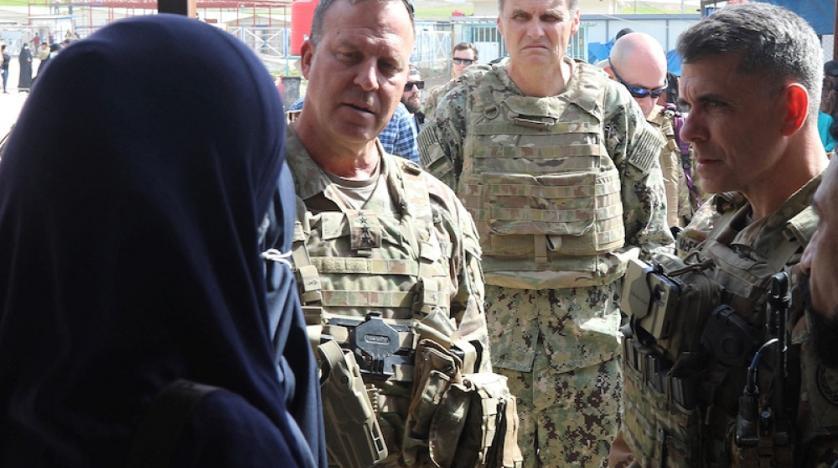
ISIS fighters and families under guard in Syria pose ‘problem from hell’ for US forces
The repatriation of Islamic State fighters, family members and refugees living in makeshift camps and prisons in Syria will take decades at its current pace, a quandary that U.S. military officials and analysts say adds to the risk of a militant resurgence.
More than 50,000 people, mostly women and children from about 60 countries, are housed at a camp named al-Hol, which was described last week by U.S. Central Command’s leader, Gen. Michael “Erik” Kurilla, as a “flashpoint of human suffering” that could foster the next generation of ISIS.
Meanwhile, about 10,000 ISIS fighters are being guarded by U.S. partner forces that need training for corrections work and are said to be suffering from low morale.
Without U.S. support, those guards would likely leave, and the chance of ISIS regrouping soars. Paradoxically, the U.S. presence means other countries are less likely to do much about repatriating the families and even less about taking back the prisoners, regional analysts said.
“It’s a problem from hell, and until the international community comes together to clean this up, it’s a bomb waiting to go off,” said Jonathan Lord, senior fellow at the Center for a New American Security, a Washington-based think tank.
The al-Hol camp, which is operating at about 500% of capacity, lacks adequate water and shade from the desert sun, CENTCOM statements have said.
Not all those being held at the camp are related to the ISIS fighters. Some fled there to escape the terrorist group, CENTCOM said. But indoctrination is prevalent among the 25,000 children being held there, according to U.S. officials.
ISIS fighters have smuggled people and weapons through the camp, including 300 men caught with explosives at al-Hol during a sweep last year, a Politico report in March said.
The U.S. military is working to build more secure facilities at al-Hol and the detention facility in Hasakah, located about 30 miles away in northeast Syria.
A Pentagon budget request submitted in March also shows that the military is training guard personnel from the Syrian Democratic Forces, a Kurdish group opposed to Syria’s government. The entire guard force needed to be replaced over the last year after a jailbreak battle that left hundreds dead, a 2022 Congressional Research Service report said.
But the best solution is moving the families and prisoners out of the conflict, where ISIS continues to fight a low-level insurgency despite losing its last territory in 2019, said Mona Yacoubian, a senior adviser at the United States Institute of Peace, based in Washington.
“The longer there are a large number of residents in the camp, the greater the prospects for a significant security breach or attack on the camp,” Yacoubian said.
U.S. military leaders have said that the slow repatriations remain “the biggest impediment to ensuring the enduring defeat of ISIS.”
The 10,000 ISIS detainees consist of approximately 5,000 Syrians, 3,000 Iraqis and 2,000 foreign fighters, the 2022 Congressional Research Service report said.
Iraq has agreed to take back its citizens, but many parts of Syria aren’t peaceful enough to allow anyone to be sent back, analysts said.
Returning the foreign fighters and their families is particularly tricky. Suspicion of affiliation with ISIS, regardless of whether it’s been proved, makes taking them back politically toxic for governments, Yacoubian said.
Some European countries have said they’re willing to take the women and children back but have shown little to no interest in bringing home the fighters.
In other cases, the U.S. does not want to send fighters and their families to countries where they will not receive due process and may be subject to summary execution.
In the meantime, foreign governments are effectively outsourcing the problem to the U.S. military, even as CENTCOM calls for swift repatriations.
“It allows them, unfortunately, to not make a decision, because in the meantime the (fighters) are still being detained and not directly threatening them,” said Jerome Drevon, a senior analyst at the Brussels-based International Crisis Group.
If the U.S. military left Syria or stopped supporting the partner forces, ISIS would swiftly be able to re-form within a year, analysts said, echoing similar comments by Kurilla.
“This is based on the likelihood that the (Syrian Democratic Forces), without the resources of U.S. troops, would most likely not maintain the prisons, likely abandoning them or allowing ISIS to break out,” said Charles Lister, a senior fellow at the Middle East Institute, a Washington-based think tank.
Lister recently visited Hasakah, where a prison break foiled days before his arrival revived memories of the successful escape last year that required U.S. special operations forces to intervene. That 10-day battle left 500 ISIS and SDF fighters dead, CENTCOM said at the time.
Meanwhile, an ISIS ambush critically injured an SDF soldier during the recent visit.
The SDF leadership there was asking “how long are we going to have to secure and guard your citizens,” Lister said.
Source » stripes





